Introduction
Sillimanite is a typical mineral of high grade Al-rich metamorphic rocks, and mindat lists 1301 localities (November 2013). It is the high grade polymorph of kyanite and andalusite. At prograde metamorphism (or at a later, higher grade metamorphic event), sillimanite may replace kyanite and/or andalusite, and two (rarely all three) of these polymorphs often occur together.
Sillimanite is normally found as white needles or fibrous aggregates in gneiss or schists. Isolated prismatic crystals of any size are relatively rare, and then found in pegmatites or quartz veins in sillimanite-bearing schist/gneiss. It is sometimes used as a gem, as brown chatoyant crystals and aggregates are known from several localities, among them southern India and Sri Lanka. The finest light blue, transparent crystals are found in the gem sands of Sri Lanka and Burma. These stones are sometimes faceted and occasionally dyed red to simulate rubies. As sillimanite is normally found embedded in gneiss and schists, free-standing crystals are rare to non-existent. The only exception is as small (mm sized) crystals formed by high temperature contact metamorphosis of Al-rich sediments or low grade schists. The Eifel district of Germany is one of the few places where sillimanite is found in Al-rich pelitic xenoliths.
Sillimanite was first described as "fibrolite" by Count de Bournon (1802) from southern India, where it was found as fibrous aggregates accompanying corundum. The mineral was later described as sillimanite from Chester, Connecticut by Bowen (1824).
Antarctica
"Christmas Point" pegmatite, Khmara Bay, Casey Bay, Napier Complex, Enderby Land, Eastern Antarctica, Antarctica
The Christmas Point area is part of a UHT (Ultra-High Temperature) metamorphic domain belonging to the Napier complex. The estimated peak P-T conditions range from 1050 to 1100o C and 8 to 11 kbar. Multiple metamorphic events are mapped since the protholite (a tonalite intrusion) formation of the orthogneiss at 3.8-3.95 Ga. It is agreed that a major metamorphic event took place 2.4-2.5 Ga, but whether this event was at the peak conditions is debated. The rocks today are dominated by well layered gneisses, of which garnet -orthopyroxene gneiss and garnet felsic gneiss are the most abundant types. Orthopyroxene-bearing quartz-rich granulite, layering of which is indistinct to massive, is present as layers within the garnet felsic gneiss.
The granulite-facies rocks of the Napier complex are cut by two generations of pegmatites. An early generation includes pegmatites dated near the metamorphic event at 2.4-2.5 Ga. These pegmatites are found at many exposures in the Napier complex, but are nowhere abundant. They may contain relatively high Be-content and host some very rare minerals. Pegmatites of the early generation form cross-cutting planar veins up to 1 m across and as irregular masses, some of which are associated with boudinage, or pods. The last are generally 0.5-2 m thick and extend up to 4 m; they lie at a high angle to the compositonal layering. The early pegmatites have a granulite-facies mineralogy.
The later generation pegmatites are associated with the last metamorphic event at dated at 520 Ma. The later pegmatites are abundant in Casey Bay but are rare elsewhere in Enderby Land. They form: 1) cross-cutting veins up to 4 m in width and up to at least 350 m in extent; 2) subconcordant pods or 3) large masses several meters and more across.
The "Christmas Point pegmatite" is one of the older pegmatites and is 1.5 m thick. It is one of a series of pods in a layer of quartz granulite containing sapphirine, orthopyroxene, sillimanite, and garnet. This granulite is part of a block of relatively unaltered granulite-facies rocks within a tectonic zone of extensive deformation and retrogression.
The pegmatite consists of coarse-grained (>1 cm) quartz, microcline, apatite, biotite and sillimanite, and of medium-grained (mostly 0.05 - 2 mm), dense segregations rich in sillimanite, garnet, cordierite, biotite, apatite and surinamite. In hand specimens, much of the microcline is red. Sillimanite crystals (up to l0 cm long and 3 cm across) are white or brown; the brown sillimanite is chatoyant. The brown color is due to a Fe2O3 content (1.35%) as well as inclusions of Fe-rich minerals as numerous, fine acicular inclusions. These inclusions are the cause of the chatoyancy effect. The brown color is not evenly distributed in the crystal, and is typically most intense in patches where the inclusions are most numerous.
These sillimanite crystals are clearly among the largest individual crystals of the mineral that have yet been found. They are, for obvious reasons, scarcely available.
References:
Edward S. Grew (1981): Surinamite, taaffeite, and beryllian sapphirine from pegmatites in granulite-facies rocks of Casey Bay, Enderby Land, Antarctica. American Mineralogist, Volume 66, pages 1022-1033.
Masao Asamia, Kazuhiro Suzuki , Edward S. Grew (2002): Chemical Th–U–total Pb dating by electron microprobe analysis of monazite, xenotime and zircon from the Archean Napier Complex, East Antarctica: evidence for ultra-high-temperature metamorphism at 2400 Ma. Precambrian Research Vol. 114, pp 249–275.
Yasutaka Yoshimura, Tomaharu Miyamoto, Edward S.Grew, Christopher J. Carson, Daniel Dunkley and Yoichi Motoyoshi (2001): High grade metamorphic rocks from Christmas Point in the Napier Complex, East Antarctica, Polar Geoscience Vol .14 pp 53-74.
George R. Rossman (1982) The colors of sillimanite, American Mineralogist, Volume 67, pages 749-761.
Germany
Laacher See Volcanic Complex, Germany
The sillimanite from Eifel rarely exceeds a couple of mm, but it still deserves a place in this article as it covers the occurrence of sillimanite as a HT/LP mineral in volcanic xenoliths. This type of occurrence is also unique in that sillimanite can be found as vug material.
Volcanism in Eifel is a part of a series of intra-plate volcanic fields in Central Europe that have been active throughout the Tertiary and Quaternary and is largely related to rifting of the Rhine Graben and broad uplift of pre-Tertiary basement in the Rhenish Shield. Xenoliths and ejecta from various rocks are common, and host a wide range of different minerals.
Sillimanite is found in Eifel mostly as fibrous dense masses, and its occurrence is restricted to ejecta of politic metamorphic rocks or xenoliths of either schists of staurolite/garnet or granulite facies in lava flows. Thin columnar to fibrous crystals of the paragenesis, such as the Nickenicher Weinberg (553) and tiny, flattened sprays of needle-like crystals (Fibrolite ) in cavities are rare. The sillimanite aggregates are usually colorless or whitish , but they can also be slightly yellowish, brownish or reddish colored. Of the many possible associated minerals, here are only cordierite, andalusite, rutile, corundum and also spinels (hercynite and spinel proper) and graphite. Spinel and corundum may be formed from sillimanite by pyrometamorphism .
Intergrowths of sillimanite and andalusite are known. It is unclear whether these minerals both are primary or if one of them has been formed at the expense of the other, except for one case where a square cross section gave away the andalusite origin
References:
Blass et al. (2006): Die Minerale der Vulkaneifel, DVD, sillimanite entry.
Günther Blass, Personal communication.
Axel K. Schmitt, Florian Wetzel, Kari M. Cooper, Haibo Zou, Gerhard Wörner (2010): Magmatic Longevity of Laacher See Volcano (Eifel, Germany) Indicated by U-Th Dating of Intrusive Carbonatites, Journal of Petrology Vol. 51, No 5, pp1053-1085.
Peter M. Sachs and Thor H.Hansteen (2000): Pleistocene Underplating and Metasomatism of the Lower Continental Crust: a Xenolith Study, Journal of Petrology.
Shigeo Aramaki (1961): Sillimanite and cordierite from volcanic xenoliths, American Mineralogist, Vol 46, pp1154-1165.
India
Odisha, India
Orissa is not a very specific locality, and there are probably dozens of places in the state of Orissa that may produce similar or larger sillimanite crystals. This specimen was probably found as a loose crystal in the soil or on a beach, as the Precambrian quartz-sillimanite-garnet (khondalite) of Orissa is often heavily weathered. It also would seem difficult to free such a crystal from from fresh khondalite. The khondalite rocks are considered to be granulite facies-upper amphibolite facies metamorphic equivalents of a deeply weathered soil profile.
Italy
Nibbio-Val Faera (Nibbio-Val Fredda) pegmatites, Nibbio, Mergozzo, Verbano-Cusio-Ossola Province, Piedmont, Italy
Cuzzago-Proman pegmatite veins, Premosello-Chiovenda, Verbano-Cusio-Ossola Province, Piedmont, Italy
Sillimanite in the steep slopes of Val d’Ossola is found in rocks belonging to the Ivrea-Verbano Zone, which is a narrow area near the border of the European and the Apulian plates. The Ivrea-Verbano zone roughly consists of a mafic layered intrusion and an amphibolite to granulite facies formation, the Kinzigite Formation. Sillimanite is a rock forming mineral in a semi-pelitic gneiss where it forms fibers (sillimanite var. fibrolite) in amphibolite facies gneiss and small prismatic crystals in the granulite facies gneiss.
Mineral collectors are more interested in the up to 20 cm long sillimanite crystals found in pegmatites penetrating the gneiss, where it occurs with microcrystals of zircon and monazite. It appears that the pegmatite origin is recrystallized molten sillimanite-bearing gneiss.
References:
http://www.mindat.org/mesg-105-308121.html
James E. Quick, Silvano Sinigoi, Arthur W. Snoke, Thomas J. Kalakay, Adriano Mayer and Gabriella Peressini (2003): Pamphlet to accompany Geologic Map of the Southern Ivrea-Verbano Zone, Geologic Investigations Series Map I-2776.
E. Rutter, K. Brodie, L. Burlini (2009): The Ivrea-Verbano Zone – Valle d’Ossala excursion, Field Trip Guide, 8th Euroconference of Rock Physics and Geomechanics.
Myanmar
Mogok Township, Pyin-Oo-Lwin District, Mandalay Region, Myanmar
According to Spencer (1920), the first description of sillimanite from the Mogok stone tract was as a rock constituent by Brown and Judd (1896). Spencer's description of " the specimens from the ruby mines at Mogok, Upper Burma...were generously presented to the British Museum early this year by Mr. A. H. Morgan, a member of this Society and formerly superintendent of the Burma Ruby Mines. They had been labelled as 'andalusite', and were correctly identified in the first place by Dr. G. T. Prior." This was the first time gem grade specimens were known.
These specimens gathered by Mr. Morgan included, again according to Spencer (1920), "a fine, faceted gem and a parcel of water-worn crystals and pebbles. Amongst the latter was one very pale sapphire, but the eighteen others proved to be fibrolite. The only information given with the specimens was that they were picked out of the hill wash at the ruby mines. The cut stone is perfectly clear, transparent, and flawless, and is of a pale sapphire- blue colour, somewhat resembling cordierite ('water-sapphire') in appearance. Its weight is 0.816 gram, and sp. gr. 3.25. The rough stones have the form of rhombic prisms which are considerably rounded, and, when still more water-worn, of elongated pebbles. They are 1-11/2 cm. long by 1/2-3/4 cm. across.
When in their original matrix, they evidently were perfectly developed crystals. They are quite clear and transparent, and of a pale sapphire-blue colour, ranging in some crystals to almost colourless. Pleochroism is strong. The maximum colour is seen when the crystals are viewed across the prism-zone, whilst in the direction of the vertical c-axis they are colourless."
Although the largest gem sillimanite from Mogok as reported by Spencer was no larger than 1 1/2 cm, larger crystals have been found since. Bukanov (2012) reports sillimanite crystals up to 5 cm.
Rossman (1982) did not find any characteristic trace element pattern that could explain the blue color commonly seen in Mogok sillimanite. He speculates that the blue color may be a result of rapid quenching from high temperatures under reducing conditions (i.e.,low Fe2O3) may be instrumental in developing the blue color in sillimanite, but he is not convinced himself, as the wavelength of the color is similar to that of kyanite that is also blue in slow cooling environments.
Gem grade sillimanite has not been found in situ in Mogok, but sillimanite grade schists and gneisses occur at several places in the Mogok Metamorphic Belt. They originate from Cambrian(?) metasediments. Searl et al. (2007) find that a metamorphic event occurred prior to 59.4 Ma. This metamorphic episode occurred before the early Eocene India-Asia collision. The sillimanite probably was proably formed later as " A second, postcollisional high-grade sillimanite metamorphic event occurred between 37 and 29 Ma and may have lasted as long as 47-24 Ma, when metamorphic zircon overgrowths and metamorphic monazites crystallized."
References:
M. P. Searle, S. R. Noble, J. M. Cottle, D. J. Waters, A. H. G. Mitchell, Tin Hlaing, M. S. A. Horstwood (2007): Tectonic evolution of the Mogok metamorphic belt, Burma (Myanmar) constrained by U-Th-Pb dating of metamorphic and magmatic rocks, Tectonics, Vol. 26, pp 1-24.
Vladimir V. Bukanov (2008): ЦВЕТНЫЕ КАМНИ Энциклопедия. Parts of this book are presented in English as the "Coloured stone encyclopedia" by the Russian Mineralogical Society ( http://gems.minsoc.ru/).
L. J. Spencer (1920): Fibrolite (= Sillimanite) as a Gem-Stone from Burma and Ceylon, Mineralogical Magazine Vol. 19, pp 107-112.
Sri Lanka
Ratnapura, Ratnapura District, Sabaragamuwa Province, Sri Lanka
Sri Lanka consists to a great extent of granulite facies metamorphic rocks originating from the Pan-African orogeny. These rocks are the source of the gem gravels of the island, where a multitude of gemstones, including sillimanite, can be found. It is meaningless to speculate on the origin of the sillimanite crystals, as it is common in outcrops all over Sri Lanka, and single crystals are rarely found in situ.
One of the earliest written accounts of gem sillimanite from Sri Lanka is a single, long prismatic crystal measuring 4 mm across described by by F. Grünling (1900). These crystals are similar to, but seemingly smaller than, the ones found in Mogok. In addition, deep brown to black pebbles and crystals up to at least 2 cm are known. These show a sharp chatoyancy. Investigations by Gübelin et al. (1986) show that these sillimanites have elongated inclusions of hercynite/pyroxene and ilmenite. It is the latter that causes the cat’s eye effect. The inclusions are 0.05 - 0.5µm across, with a rectangular cross-section that is probably imposed by the sillimanite structure. Strangely, both types of inclusions can be up to 1mm in length, showing a long-prismatic habit uncommon both for hercynite and ilmenite.
References:
E. Gübelin, M. Weibel, and C. P. Woensdregt (1986): Some unusual sillimanite cat’s-eyes. Gems & Gemology, Vol. 22, No.2, pp 96-98.
L. J. Spencer (1920): Fibrolite (= Sillimanite) as a Gem-Stone from Burma and Ceylon. Mineralogical Magazine Vol.19, pp 107-112.
P. Raase & V. Schenk (1994): Petrology of granulite-facies metapelites of the Highland Complex, Sri Lanka: implications for the metamorphic zonation and the P-T path. Precambrian Research Vol. 66, pp 265–294.
USA
Sillimanite type locality, Chester, Middlesex County, Connecticut, USA
Sillimanite is found here as a common constituent of schists and gneisses ot the Tatnic Hill Formation. The sillimanite schists originate from Proterozoic(?) sediments, which have been exposed to multiple metamorphic events with deformation and peak metamorphism during the Devonian Acadian orogeny responsible for the formation of sillimanite.
Gray to brown sillimanite crystals are found embedded in quartz lenses in the gneiss, and the individual crystals may reach lengths of multiple cm from several lovclaities in the area.
Chester is considered the type locality for sillimanite as Bowen (1824) published an article describing “this substance (that) most strongly resembles in external characters, the anthophyllite, and the…analysis proves them to be totally distinct. Nepheline is the only mineral to which the subject of this paper is allied in chemical composition.” Bowen concluded “therefore, the substance which I have analyzed, must be considered a new species in mineralogy, and I propose for it the name of Sillimanite, in honour of Professor Silliman”
Professor Silliman himself was probably aware that an identical (in appearance as well as chemistry) mineral had been described as fibrolite 22 years prior to Bowen’s article. Silliman was one of the reviewers of Parker Cleaveland’s "An elementary treatise on mineralogy and geology", in which Cleaveland not only describes fibrolite in details but also refers to Bournon’s original description from 1802.
References:
Mindat locality description.
USGS Mineral resoources-online spatial data.
George T. Bowen (1824): Description and Analysis of the Sillimanite, a new mineral. American Journal of Science and Arts; 8,1 p 113.
Parker Cleaveland( 1822): An elementary treatise on mineralogy and geology.
Robert L. Herbert (?):The Complete Correspondence of Edward Hitchcock and Benjamin Silliman, 1817-1863, Amherst College publication.
Jay J. Ague and James O. Eckert, Jr. (2012): Precipitation of rutile and ilmenite needles in garnet: Implications for extreme metamorphic conditions in the Acadian Orogen, U.S.A. American Mineralogist, Volume 97, pp 840–855.
Falls of the Yantic River, Norwich, New London County, Connecticut, USA
Also from this locality, sillimanite are found as several cm long grystals in gneiss belonging to the Tatnic Hill Formation
Willimantic, Windham, Windham County, Connecticut, USA
Gray to brown sillimanite crystals are found embedded in quartz lenses in gneiss belonging to the Tatnic Hill Formation. "Yale has similar brown crystals embedded in quartz from several other places around Connecticut, all from the Tatnic Hill Formation, which is very wide-spread in eastern Connecticut. However, these quartz veins are rather scarce and I have yet to find any myself." Harold Moritz 2013
Brandywine Springs, New Castle County, Delaware, USA
Sillimanite is widespread throughout the schists metamorphosed during the Taconic Orogony (470 and 440 Ma) belonging to the Delaware Piedmont. It occurs as large masses and steam-rounded boulders at the Brandywine Springs State Park. This area was known before 1830 and was recognized as a notable locality in the 6th edition of Dana's System of Mineralogy (1892). The Brandywine Springs boulders are remarkable for their size and purity. The sillimanite has a greasy to somewhat fibrous texture (var. "Fibrolite"), which is reminiscent of wood. In 1977, the Delaware General Assembly, acting on a proposal by the Delaware Mineralogical Society, established sillimanite as the Delaware State Mineral.
References:
Delaware Goelogical Survey website.
Mark Heintzelman (2013): Mindat messageboard.
Benson Mines, Benson, Star Lake, St. Lawrence County, New York, USA
The Benson Mines were worked for a magnetite/hematite ore hosted in a Grenville-age gneiss. It was mined in an open pit that was about 4 kilometers long and 244 meters wide. The pit itself is filled with water, but mineral samples from the mining operations can still be found around the lake. The ore was discovered in 1810 and was worked on and off in the period from 1819 to 1970. The New York State Geological Survey has published an online article on the Benson Mine, and I would like to quote the following:
"While the mine does not contain an exceedingly large number of mineral species, some very exquisite and unusual mineral specimens have been collected over the years from the site. Many of these samples now exist in private or institutional collections like Canadian Museum of Nature and the New York State Museum." The above right photo show an approximately 15 cm crystal on display in the New York State Museum in Albany. Unfortunately, the information about the minerals from this deposit is very scarce and the locality did not catch the attention of many of mineral collectors.
Sillimanite is one of the minerals that has been found in good crystals. It is found as a rock-forming mineral in the ore-hosting gneiss, but I have not found any details of the origin of the well formed crystals that can be found at this locality. The gneiss originates from Al-rich sediments that have undergone multiple metamorphic events, with peak conditions estimated at 600-650o C and 6-8 kbar.
References:
Benson Mine, Star Lake, St. Lawrence County, NY, New York State Geological Survey.
Olav Revheim November 2013
Reviewed by Becky Coulson
Article has been viewed at least 3365 times.







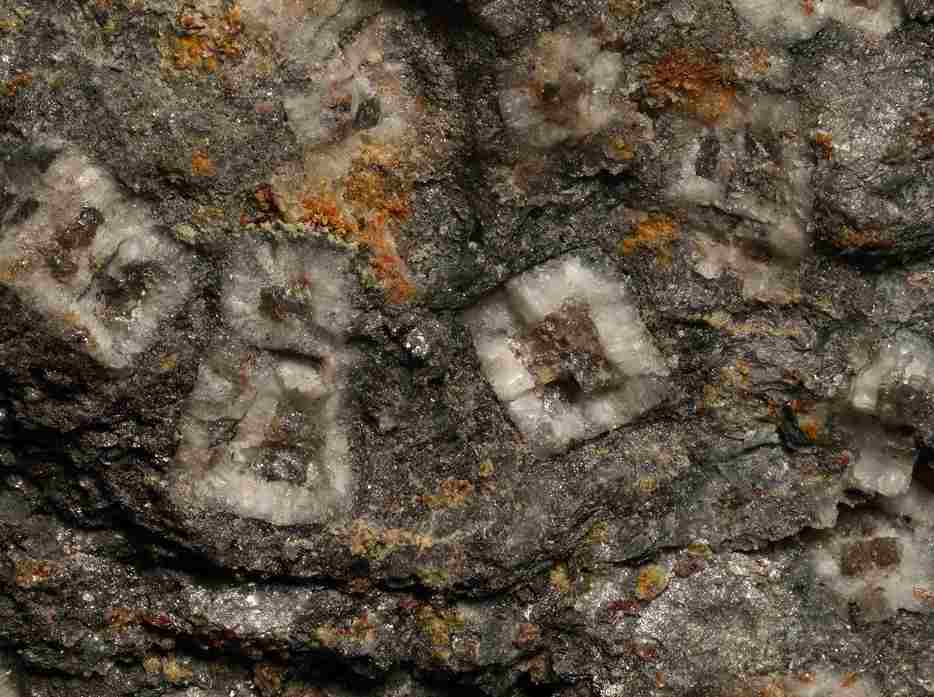









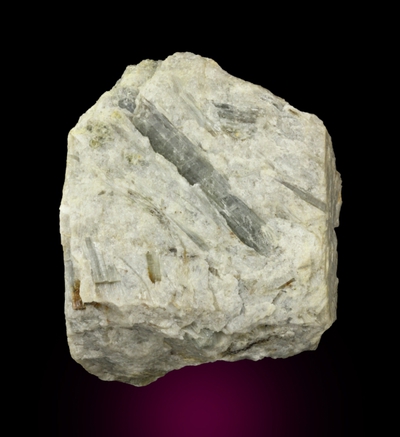








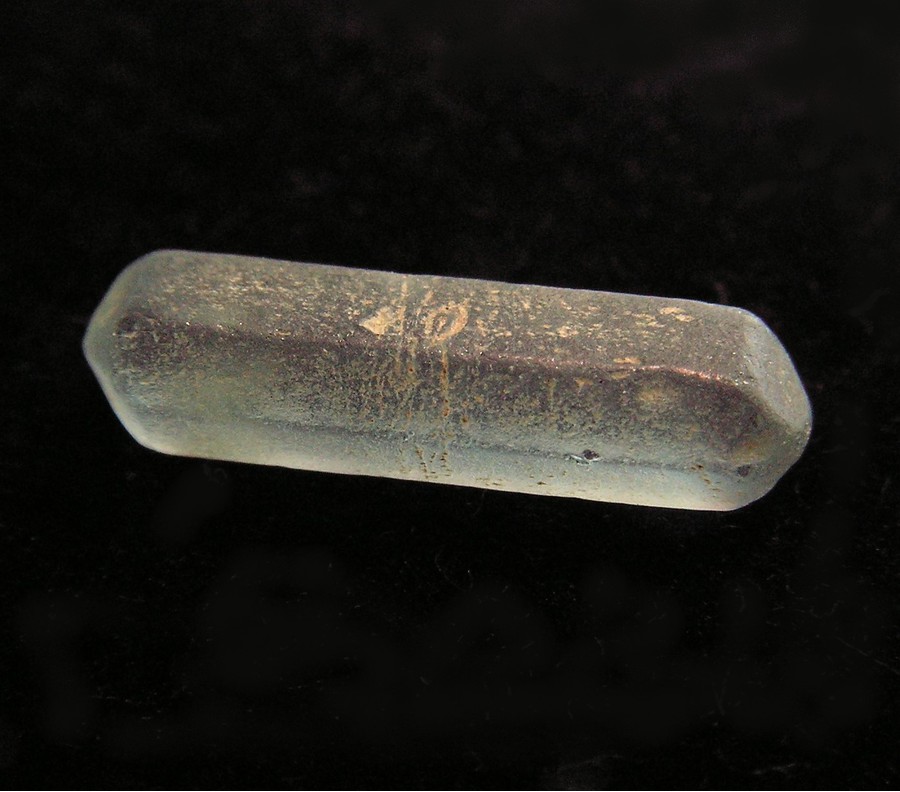





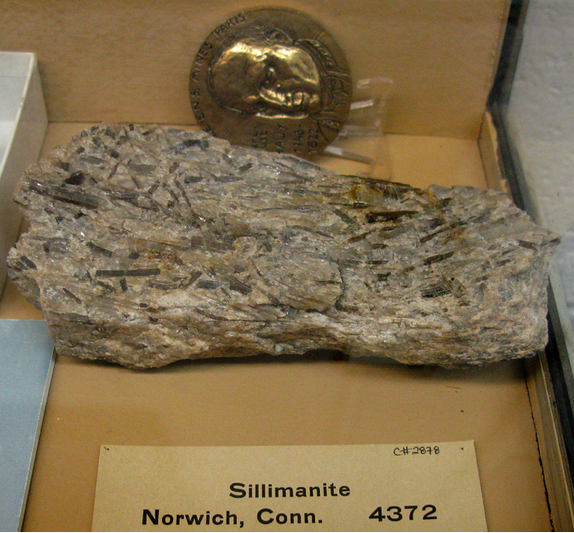

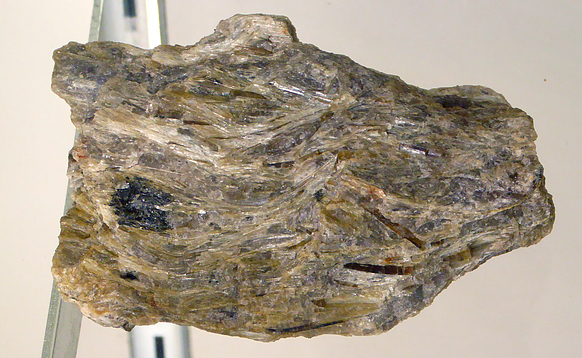



























"Christmas Point" pegmatite, Khmara Bay, Casey Bay, Napier Complex, Enderby Land, Eastern Antarctica, Antarctica